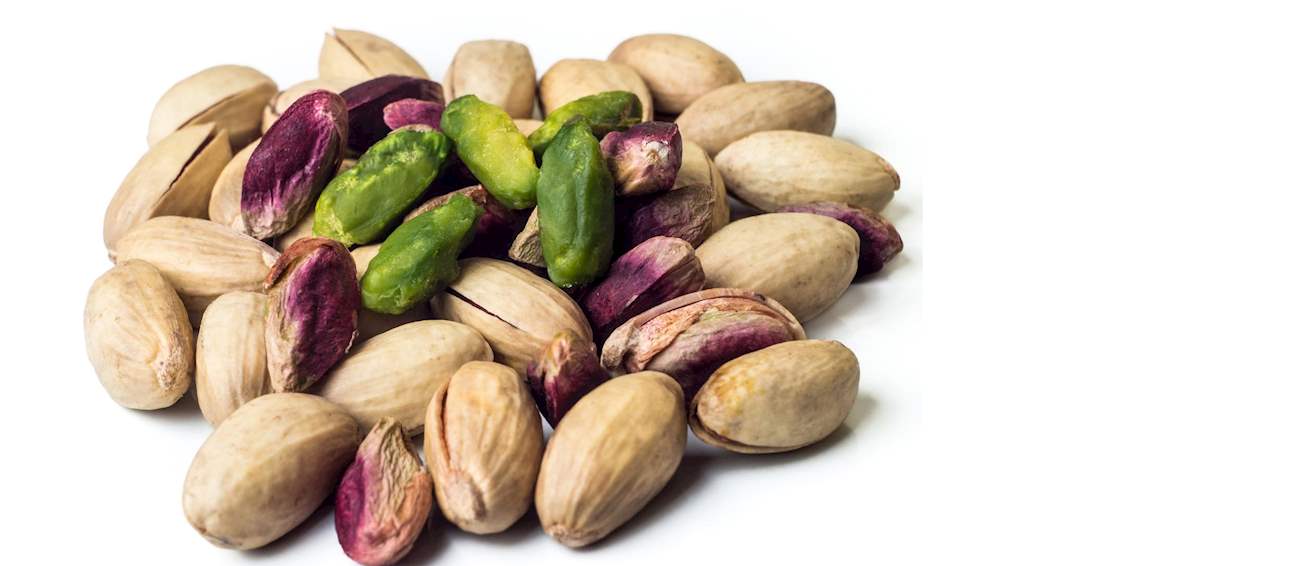TABLE OF CONTENTS
Best European Nuts Types
This is by far the most famous Greek pistachio. This amazing pistachio nut is produced from the Egintiki variety, which has been traditionally cultivated on the island of Egina since the end of the 19th century. The first pistachio plantation here was established in 1896 by Nikolaos Peroglou, who brought the nuts from Syria.
The weather conditions and the soil composition give these pistachios a recognizable aroma and taste for which they are considered among the best in the world. The harvesting season begins in August, when the nuts are collected with long wrapped sticks that are used to beat the branches without damaging the tree.
Produced within the Sicilian province of Catania, Pistacchio Verde di Bronte refers to the pistachio nuts of the Napoletana cultivar (also known as Bianca or Nostrale), grown in the fertile volcanic soils around Bronte, a small town settled at the foot of Mount Etna.
Since pistachio trees were brought to Italy from the Middle East, in Sicily pistachio is called frastuca, which is adopted from the Arab word fustuq. The versatile Bronte pistachios are traditionally used for preparing a wide variety of sweets and pastries such as cannoli, cassate, torroni or the famous fig and nuts Christmas cake called Bucellato Siciliano.
Native to Spain, this almond variety bears a smooth, white-colored fruit which has a distinctively rounder and plumper shape than other, more common almond varieties. The nut is distinguished by an exceptionally soft and moist texture, often compared to that of a macadamia nut, while the flavors are intensely sweet, delicate, buttery, and mild.
Considered to be among the finest almonds in the world, Marcona almonds are believed to be an excellent source of beneficial oils, and they are highly sought-after gourmet items, available in blanched, fried, or roasted versions, seasoned with sea salt or ingredients such as truffles, smoked paprika, chili, or rosemary.
These pistachios have been produced in the Megara administrative area in the eastern part of mainland Greece for more than a hundred years. The microclimate of this area, characterized by hot summers and mild winters with low levels of precipitation, provides the ideal conditions for the cultivation of pistachios.
Megara pistachios are cropped from the Megalokarpi, Fundukati, Nihati, and Kilarati varieties of the Pistachia vera tree. The nuts are sun dried, after which they are shelled and machine sorted. These pistachios are praised for their sweet taste and vibrant green colour.
Almonds are the world's most widely grown and consumed tree nut, and Italy is one of the major producers. Particularly rich in aroma and flavor are those cultivated in sunny Sicily, where almonds are the most widely grown fruit after olives. There are many varieties, all related to prunus amygdalus, and the most praised varieties are Pizzuta, Fascionello Romana, Cavaliera and Bonifacio nº 1.
They can be either sweet or bitter - the sweet ones are widely used in confectionery, while small quantities of the bitter ones give a typical flavor to certain types of biscuits and liquors. Sicilian almonds are harvested in July and the majority of orchards are located in the province of Siracusa, especially around the cities of Noto and Avola.
This chestnut is the fruit of the Longal varietal, grown in the Vila Real and Bragança districts in Portugal. These chestnuts are harvested manually when they fall to the ground, and the use of any mechanical instruments or tools during harvesting is forbidden.
They are reddish-brown with a bright longitudinal stripe on the exterior, and their flavor is intense and quite aromatic. Terra Fria chestnuts can be frozen or processed into jams, syrups, or caldas. They are a common accompaniment to traditional dishes such as fried meat or pork roasts, and they are also to produce bread, cakes, and chestnut flower.
This high-quality pistachio is produced in the municipalities and communes of Phthiotis prefecture. It became a traditional crop of the area in the 1940s and 1950s, and today its production contributes significantly to the local economy. Each year, in late August to early September, the pistachios are gently shaken from the trees and their outer pink hulls are removed.
Afterward, they are dried and hand-selected. Any use of chemicals or pharmaceuticals in production is forbidden, even to prevent possible diseases from being transmitted through the soil. The pistachio has a dark green color and a very pleasant flavor, and can be either salted or unsalted.
Almendra de Mallorca are almonds produced on the Island of Mallorca in Spain. They can be sold raw or roasted, with or without skin. These nuts are of exceptional quality and are rigorously tested; they must not be smaller than 12mm or have any visible defects.
They are crunchy in texture and slightly sweet in taste and should not be bitter unless they are roasted. All stages of production, including packaging, must take place on the island of Mallorca.
Traditionally produced in the neighboring provinces of Viterbo and Rome, Nocciola Romana refers to dried hazelnuts of the Tonda Gentile Romana and Nocchione varieties, grown in the micronutrient-rich volcanic soil of the Cimini and Sabatini mountains.
Whether enjoyed raw, dried or roasted, the crunchy Roman hazelnuts are packed with mono-unsaturated fats and vitamins E and K, but they're also rich in calories! In the traditional Viterbo cuisine, Roman hazelnuts are most often used as an essential ingredient in the preparation of many local desserts, including Tozzetti - anise, almond and hazelnut biscotti, as well as other biscuits such as Ossetti da Morto, Brutti Buoni and Mostaccioli Romani.
Noix du Périgord are early or dry walnuts or walnut kernels with a fine texture and a unique taste similar to black walnuts, produced in the French regions of Aveyron, Charente, Corréze, Dordogne, Lot and Lot-et-Garonne, where the walnuts must be grown, shelled and packed.
Early walnuts are fresh and sold in their shells and the nuts are white with a thin skin that can be easily peeled. Dry walnuts are gently dried and less bitter than early walnuts and the walnut kernels are small, light or dark in color and must be minimally 8 mm in size.
TABLE OF CONTENTS
Best European Nuts Producers
Valle del Taibilla, based in Nerpio, Spain, is a renowned producer of organic preserves and jams, rooted in sustainable practices. Established in the 1990s, the company prioritizes eco-friendly production and local agriculture, crafting products that include a range of organic jams made from locally sourced fruits, as well as preserved vegetables and nuts.
Notably, their organic Nerpio walnuts, grown in high-altitude orchards and harvested by hand, are recognized for their unique flavor and high antioxidant content. Valle del Taibilla’s products are certified vegan, gluten-free, and natural, reflecting their commitment to quality and environmental stewardship.
BEST Valle del Taibilla Nuts and Seeds
TABLE OF CONTENTS
Best European Nuts
The Nueces Ecológica de Nerpio, produced by Valle del Taibilla in Nerpio, Spain, are organic walnuts cultivated in the pristine mountain valleys of the Sierra del Segura. These nuts are highly regarded for their rich, authentic flavor and high nutritional content, produced without synthetic fertilizers or pesticides.
Valle del Taibilla’s approach is rooted in sustainable, traditional farming methods, preserving local biodiversity and promoting ecological balance. These walnuts are certified organic and are noted for their premium quality, making them a popular choice in Spanish and European markets.
TasteAtlas food rankings are based on the ratings of the TasteAtlas audience, with a series of mechanisms that recognize real users and that ignore bot, nationalist or local patriotic ratings, and give additional value to the ratings of users that the system recognizes as knowledgeable. TasteAtlas Rankings should not be seen as the final global conclusion about food. Their purpose is to promote excellent local foods, instill pride in traditional dishes, and arouse curiosity about dishes you haven’t tried.






































